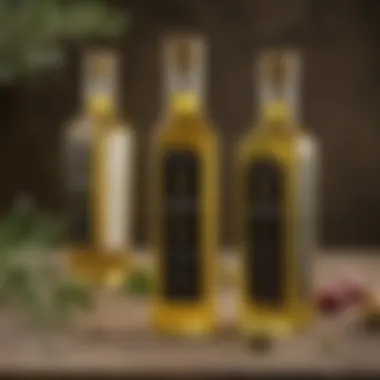Exploring Quality in Extra Virgin Olive Oil


Intro
Extra virgin olive oil (EVOO) holds a distinguished place in the culinary universe. It is not merely an ingredient; it is a complex product with a rich history and unique production methods. Understanding its landscape involves examining the various brands that produce it, the factors that influence its quality, and how one can discern the best choices for culinary applications.
This article aims to delve into these crucial aspects, presenting a detailed guide for anyone from home cooks to professional chefs. Quality is a primary focus, and recognizing the elements that contribute to a superior olive oil will enhance your culinary experiences. We will look at production processes, authenticity checks, and regional influences.
As we transition deeper into the subject, the following sections will outline the characteristics that define quality EVOO, guiding the reader in making informed choices.
Foreword to Extra Virgin Olive Oil
Extra virgin olive oil holds a prominent place in culinary traditions around the world. Its rich flavors and health benefits make it more than just a cooking fat. Understanding what distinguishes high-quality extra virgin olive oil is crucial for both chefs and home cooks. This section provides a foundation for appreciating this esteemed ingredient and sets the stage for evaluating its quality.
Definition and Standards of Extra Virgin Olive Oil
Extra virgin olive oil, often abbreviated as EVOO, is defined by stringent standards that focus on purity and flavor. To be classified as extra virgin, the oil must be produced from fresh olives, without any chemical refinement. The International Olive Council outlines specific guidelines to ensure quality, including the following:
- Acidity Level: An extra virgin olive oil must have an acidity level of less than 0.8%.
- Flavor and Aroma: It should have a distinct taste with no defects in flavor, such as rancidity or fustiness.
- Cold Pressing: The extraction process must be mechanical and done at lower temperatures to preserve its natural characteristics.
These standards not only help consumers make informed choices but also promote the authenticity of olive oil. Knowing these parameters allows buyers to distinguish quality from inferior products.
Importance in Culinary Arts
The role of extra virgin olive oil goes beyond being an ingredient. It is a critical element that can enhance the flavor profile of dishes. Its versatility spans across various cooking methods, including grilling, sautéing, and dressing salads. The oil not only elevates taste but also adds nutritional value. Rich in monounsaturated fats, it supports heart health and provides antioxidants that benefit the body.
Moreover, extra virgin olive oil holds cultural significance in many cuisines. Regions like the Mediterranean rely heavily on its use, reflecting a deep connection between the oil and traditional cooking practices. Knowledge about these connections enriches the understanding of culinary art forms and promotes a more mindful cooking experience.
A well-chosen extra virgin olive oil can thus become a pivotal ingredient in both simple and complex dishes, underscoring its importance in the culinary realm.
Understanding Quality Indicators
Understanding quality indicators is crucial when it comes to extra virgin olive oil. These indicators are essential in determining the purity, freshness, and overall quality of the product. Knowing what to look for can significantly impact culinary results, not to mention health benefits. Consumers who grasp these quality indicators can better navigate the numerous options available in the market.
When discussing quality indicators, it is vital to consider the following elements:
- Chemical composition: This aspect offers insights into the oil’s nutritional profile and authenticity.
- Sensory evaluations: Sensory analysis allows for a judgment of flavor and aroma, helping consumers identify superior products.
- Labeling and certifications: Certifications, such as PDO and PGI, provide credibility and assurance of quality.
In sum, a thorough understanding of these indicators empowers consumers to make informed choices, ensuring they select the best extra virgin olive oils for their culinary needs.
Chemical Composition
The chemical composition of olive oil plays a significant role in determining its quality. Key components include fatty acids, polyphenols, and antioxidants. A high proportion of monounsaturated fats, particularly oleic acid, is a hallmark of premium extra virgin olive oil. This composition not only enhances the flavor but also contributes to health benefits.
Polyphenols, found in a high-quality oil, are known for their anti-inflammatory properties. When shopping for extra virgin olive oil, consumers should look for oils rich in these beneficial compounds. A high content of oleic acid and polyphenols indicates a healthier choice.
Sensory Evaluations
Sensory evaluations offer a less scientific, but equally important, approach to assessing olive oil quality. These evaluations involve tasting and smelling to identify flavors, aromas, and aftertastes. A compelling extra virgin olive oil should exhibit fruity, bitter, and pungent notes.
The presence of these characteristics can indicate freshness and quality. An olive oil with a well-balanced profile will enhance dishes rather than dominate them. Therefore, sensory evaluations are essential for those who want to appreciate the full flavors and uses of olive oil in cooking.


Labeling and Certifications
Labeling and certifications are a significant part of ensuring the quality of extra virgin olive oil. These labels ensure that consumers are getting what they pay for.
PDO (Protected Designation of Origin)
PDO stands for Protected Designation of Origin. This certification verifies that olive oil is produced in a specific region and adheres to strict quality standards. One key characteristic of PDO is its requirement for oils to be made entirely from olives grown in the designated area. This provides a level of authenticity that consumers often seek.
Moreover, PDO ensures that production processes are traditional and that the oil is of high quality. The unique feature of PDO is its rigorous guidelines, which facilitate a high standard of production.
However, while PDO may guarantee quality, it can also limit options for consumers who want affordability. The region's prestige can drive up prices even though the quality may not always justify it. Still, for those seeking true artisanal products, PDO oils often represent the ideal choice.
PGI (Protected Geographical Indication)
PGI, or Protected Geographical Indication, is another certification that emphasizes regional identity. This designation allows for a broader range of production methods compared to PDO. It assures consumers that at least some part of the production process occurs in a specific area.
The PGI label is beneficial for those who seek a particular flavor profile associated with a region. A unique feature of PGI is its flexibility in production techniques, allowing producers to blend olives from different origins while still maintaining some level of geographical credibility.
Despite its advantages, the PGI certification does not offer the same stringent quality guarantees as PDO. This may leave some consumers questioning the authenticity and overall quality of the product. Nevertheless, PGI oils remain a popular choice for food lovers wanting to explore diverse flavors while still appreciating regional influences.
Factors Influencing Olive Oil Quality
Understanding the factors that influence the quality of extra virgin olive oil is crucial for both producers and consumers. These factors include various aspects of cultivation, harvesting, and production processes, each playing a significant role in determining the final product's characteristics. A premium olive oil reflects the careful consideration of these elements, affecting everything from flavor profiles to health benefits.
Cultivation Practices
Organic vs Non-organic
Organic olive oil is produced without synthetic fertilizers or pesticides. One distinct feature is the emphasis on natural processes and biodiversity. This method supports soil health and results in olives that may have a richer taste and higher antioxidant levels. Non-organic methods, while often more productive and cost-effective, involve chemical inputs that may affect the flavor and health credentials of the oil. The key characteristic of organic practices is sustainability, making them a popular choice among health-conscious consumers. However, they come with the disadvantage of potentially lower yields and higher production costs.
Sustainable Methods
Sustainable cultivation methods focus on maintaining ecological balance. This includes practices like reduced water usage and crop rotation. Such methods are growing in popularity due to the increasing awareness of environmental impacts. The distinctive feature is that they contribute to both the quality of the olives and the surrounding ecosystem. While these practices support long-term viability, they may demand more initial investment, which can deter some producers. The commitment to sustainability is beneficial for producing high-quality oil, yet it poses challenges in terms of immediate profitability.
Harvesting Techniques
Timing of Harvest
The timing of harvest is vital in determining the oil's flavor and quality. Olives picked at peak ripeness generally yield oil with optimal flavor and aroma. Harvesting too early results in a grassy taste, while late harvesting can lead to a bland profile. This critical aspect of the process emphasizes the need for attention to detail. Taking the right time can be beneficial as it ensures higher quality. However, this requires precise labor and planning, which might not always be feasible for every producer.
Methodology Variations
Different harvesting methodologies impact the quality of olive oil significantly. Traditional hand-picking offers the gentlest approach, preserving the fruits' integrity. Conversely, mechanical harvesting can cause bruising, leading to oxidization and off-flavors. The benefit of hand-harvesting lies in its ability to select only the best fruits, enhancing quality. Nevertheless, mechanical methods can be efficient for large-scale production. The choice between these methods reflects a balance between quality assurance and production efficiency.
Production and Milling Processes
Cold Pressing
Cold pressing is a method that extracts oil without heat, preserving flavors and nutrients. This technique is highly valued for its ability to maintain high quality. Cold-pressed oils usually have enhanced health benefits and flavor profiles. However, this method can be more labor-intensive and expensive than others, meaning producers must weigh costs against quality advantages. Despite higher production costs, many consumers prefer cold-pressed oils for their integrity and taste.


Extraction Methods
Various extraction methods can influence the quality of olive oil. Traditional methods like stone milling are regarded for their ability to produce flavorful oils. However, modern techniques use centrifugal force to achieve higher yields and efficiency. The choice of extraction may favor either quality or quantity. Traditional methods can result in richer flavors, while modern methods often appeal to a broader market. Both approaches have their own advantages and disadvantages, highlighting the ongoing conversation in olive oil production about finding the right balance between quality and efficiency.
Geographical Impact on Flavor Profiles
The geographical location where olives are grown plays a significant role in shaping the flavor profiles of extra virgin olive oil. This influence stems from various factors such as climate, soil composition, and traditional cultivation practices. Regions renowned for their olive oil create distinct tastes that reflect the terroir of their locality. Understanding these geographical impacts is essential for both culinary enthusiasts and professional chefs, as it aids in selecting oils that best complement their specific dishes or preferences.
Regional Varieties
Tuscan Olive Oil
Tuscan olive oil is highly regarded for its robust and peppery flavor. This quality is largely due to the variety of olives grown in Tuscany, particularly the Frantoio and Leccino olives. The key characteristic of Tuscan olive oil is its strong green fruitiness, which can leave a notable spicy finish on the palate. This unique feature makes it a beneficial choice for drizzling over grilled vegetables or incorporating into dressings, adding depth to every dish. However, its bold flavor can be overpowering in delicate dishes, thus requiring careful consideration when pairing with food.
Spanish Olive Oil
Spanish olive oil, particularly from regions such as Andalusia, is known for its diversity in flavors. The Picual and Arbequina olives are dominant varieties, yielding oils that range from fruity and mild to intense and herbaceous. The key characteristic of Spanish olive oil is its smooth texture and balanced taste. Because of these qualities, it is a popular choice for everyday cooking as well as for finishing dishes. Nevertheless, the flavor may vary significantly depending on the region and production methods, which can be both a strength and a challenge when selecting an oil that suits one's culinary needs.
Climate and Soil Influence
Climate and soil greatly affect the quality of olives and, consequently, the resulting oil. Olive trees flourish in Mediterranean climates, which are characterized by hot, dry summers and mild, wet winters. These conditions contribute to the development of oils with unique flavors and aromas. Additionally, the mineral content in the soil can highlight certain flavor notes, creating variations that appeal to different tastes. Therefore, understanding the specific climate and soil conditions of the region can guide consumers in selecting oils that will enhance their culinary creations.
Evaluating and Selecting Quality Brands
Evaluating and selecting quality brands of extra virgin olive oil is a crucial aspect for both culinary enthusiasts and professional chefs. The choice of brand can greatly affect not only the flavor profiles of dishes but also the health benefits associated with olive oil. High-quality extra virgin olive oil can provide significant advantages over lower quality alternatives, such as improved taste, enhanced nutritional properties, and authenticity in cooking.
When evaluating brands, several specific elements come into play. Understanding the labeling and certifications is essential. For example, certifications such as PDO (Protected Designation of Origin) and PGI (Protected Geographical Indication) can signal authenticity and quality assurance to consumers. Additionally, consumer reviews and professional recommendations serve as vital resources in the decision-making process. They provide insights that extend beyond marketing claims, helping buyers determine which brands deliver on their promises.
Top Brands in the Market
Brand A Overview
Brand A is recognized for its exceptional quality and commitment to authentic production processes. This brand also emphasizes sustainable farming practices, which resonate well with environmentally conscious consumers. The key characteristic of Brand A is its use of olives sourced from specific regions known for their unique flavor profiles. This regional focus enhances the oil's distinctive taste, making it a favored choice for those seeking premium extra virgin olive oil.
One unique feature of Brand A is its dedication to cold-press extraction methods, which preserve the natural flavors and nutrients found in olives. The advantages of choosing Brand A include assurance of high quality and transparency in sourcing. However, some may find the price point to be higher compared to mass-market options, which could limit accessibility for a broader audience.
Brand B Overview
Brand B stands out in the market due to its innovative blending techniques and awards received in various competitions. Known for its balanced flavor that appeals to a wide range of palates, Brand B represents a harmonious integration of different olive varieties. This key characteristic makes it a popular option among chefs and home cooks alike.
The unique feature of Brand B is its use of traditional methods in combination with modern technology. This approach not only ensures quality but also facilitates consistency in flavor across different batches. The advantages of Brand B include its versatility in culinary applications, making it suitable for various dishes. On the downside, some consumers may question the authenticity of blends compared to single-origin oils.
Consumer Reviews and Ratings
Consumer reviews and ratings offer valuable insights into personal experiences with various brands of extra virgin olive oil. Reviews can indicate the overall quality, flavor, and usability of the oil in different culinary contexts.
When evaluating consumer feedback, it is essential to consider consistency in opinions regarding taste and aroma. Often, products that receive high marks for quality and flavor tend to elevate culinary creations substantially. In addition, consumers may discuss how the oil performed in cooking, including its behavior under heat and integration with specific dishes.
Professional Recommendations


Professional recommendations typically come from chefs, food critics, and industry experts who have experience with numerous olive oil brands. Their insights can help guide consumers toward reliable choices.
Frequently, professionals will endorse brands based on rigorous tasting evaluations that assess various factors such as flavor intensity, mouthfeel, and aroma. Trusted experts often provide recommendations based on their firsthand experiences and culinary knowledge, which can assist consumers in making informed decisions about which brands to select. Ultimately, melding professional opinions with personal tastes can lead to the selection of high-quality extra virgin olive oil that fulfills both culinary and health needs.
Best Practices for Purchasing Extra Virgin Olive Oil
Purchasing high-quality extra virgin olive oil requires attention to detail. Knowing what to look for can greatly enhance both the taste and health benefits of this premium product. It is important to pay attention to various factors such as storage conditions and shelf life to ensure you are getting the best oil possible.
Storage Considerations
Temperature
The temperature at which olive oil is stored plays a significant role in maintaining its quality. Ideally, extra virgin olive oil should be kept at a temperature between 15 to 20 degrees Celsius. Temperatures that are too high can lead to rancidity, resulting in off-flavors. This optimal range helps preserve the oil's flavor compounds and health benefits, allowing the consumer to enjoy it at its best. Storing olive oil at room temperature is a popular choice, as it offers convenience while still being effective. However, prolonged exposure to elevated temperatures should be avoided, as this compromises the integrity of the oil.
Light Exposure
Light exposure is another critical factor influencing the quality of extra virgin olive oil. Ultraviolet light can degrade the oil and alter its taste, making it essential to keep it in a dark place or in opaque bottles.
Olive oil that is shielded from light is more likely to retain its flavor profiles and nutritional benefits. This characteristic makes dark glass or tin containers a preferred choice when purchasing olive oil. Not only do they protect the oil from harmful light, but they also convey a sense of quality to the consumer.
Best Before Dates and Freshness
Best before dates are crucial indicators of freshness when purchasing extra virgin olive oil. Consumers should always check for a date on the label. Ideally, olive oil should be consumed within 18 to 24 months of bottling for optimal flavor and health benefits.
Freshness is paramount; oxidized olive oil not only lacks flavor but may also contain reduced nutrients. Buyers should also be aware that oils labeled as "cold-pressed" or "first cold-press" are generally fresher and of higher quality.
When trying to maximize your culinary experience, selecting oils from recent harvests is wise.
Cooking with Extra Virgin Olive Oil
Cooking with extra virgin olive oil is more than just a culinary preference; it is a celebration of flavor, health, and tradition. This type of olive oil offers distinct advantages, making it a valuable ingredient in kitchens around the world. First, its rich flavor profile enhances dishes significantly. The right quality extra virgin olive oil can add depth and aroma, transforming ordinary meals. Furthermore, it has numerous health benefits, such as being high in monounsaturated fats and antioxidants. These nutritional advantages can support heart health and contribute to overall well-being.
When considering cooking with extra virgin olive oil, it is essential to keep a few factors in mind. Not all extra virgin olive oils are the same. Factors like production methods, olive varieties, and freshness dramatically impact taste and quality. Thus, selecting an authentic product is crucial. Moreover, temperature tolerance during cooking plays a role. While extra virgin olive oil is suitable for many cooking applications, using it at high temperatures for frying, for example, may degrade its quality. Understanding these aspects allows individuals to maximize the oil's potential without sacrificing its benefits.
Pairing with Foods
Pairing extra virgin olive oil with food can elevate a meal to new heights. The oil’s flavor notes vary based on its origin, such as grassy, fruity, or peppery. These characteristics can complement certain dishes exceptionally well. For example, a peppery Sicilian olive oil pairs beautifully with grilled vegetables or fish, enhancing their natural flavors.
- Salads: Drizzling high-quality extra virgin olive oil over fresh greens can enhance their taste. Adding a hint of balsamic vinegar or lemon juice creates a refreshing salad dressing.
- Pastas: A splash of extra virgin olive oil combined with garlic and herbs can create a delightful pasta dish. It serves as a base for sauces, enriching the entire experience.
- Dips: Using it in dips, like hummus or tapenade, can add that extra flavor touch, making it more appealing to the palate.
- Baking: Surprisingly, some bakery items benefit from the richness of extra virgin olive oil, providing moisture and depth to breads and cakes.
Uses in Different Cuisines
The versatility of extra virgin olive oil is evident across various global cuisines. In Mediterranean cooking, it is a staple, used for dressing salads and drizzling over dishes before serving. Its usage in Italian cuisine cannot be overstated, where it is often used as a finishing touch on pizza and pasta.
In contrast, Middle Eastern dishes integrate extra virgin olive oil in ways that reflect regional spices and ingredients. It plays an essential role in traditional recipes like za’atar, which combines herbs and oil. Similarly, in Spanish cuisine, it is integral in preparing dishes such as gazpacho, enriching the flavors while promoting authenticity.
Understanding these applications allows food lovers to appreciate the cultural significance of extra virgin olive oil while enhancing their cooking skills. Embracing this ingredient with respect to its origins and qualities can unlock countless culinary possibilities.
The End: The Value of Quality Extra Virgin Olive Oil
High-quality extra virgin olive oil holds significant value in both health and culinary applications. Recognizing its benefits is essential for anyone who enjoys cooking or is attentive to dietary choices. This oil is not just a flavor enhancer but also contributes to overall wellness due to its rich content of antioxidants, monounsaturated fats, and various bioactive compounds.
Health Benefits and Culinary Applications
In recent years, extensive research has underscored the health benefits of extra virgin olive oil. Studies suggest that regular consumption can help reduce the risk of heart disease, stroke, and certain types of cancer. The polyphenols found in this oil, such as oleocanthal, possess anti-inflammatory properties that can be protective to health. Incorporating extra virgin olive oil into a balanced diet can also aid in digestion and support weight management.
From a culinary perspective, its versatility cannot be overstated. Extra virgin olive oil can enhance the flavors of many dishes. It is suitable for salad dressings, marinades, and as a finishing oil on cooked foods. It brings out the best in roasted vegetables and grilled meats alike. Additionally, its compatibility with various spices and herbs makes it an indispensable ingredient for creating distinct flavor profiles across diverse cuisines.
Final Thoughts on Brand Selection
Selecting quality brands of extra virgin olive oil is crucial. Poor quality products can diminish the overall benefits and flavor that this oil offers. Consumers should seek brands that provide transparency about their sourcing and production methods. Look for indications of freshness, such as harvest dates, and consider certifications like PDO or PGI, which guarantee the product’s authenticity and quality.
Ultimately, the value of high-quality extra virgin olive oil extends beyond taste. By choosing reputable brands, consumers invest in their health and culinary experiences. Harnessing the benefits of this exceptional oil enhances not just dietary preferences, but also enriches the overall experience in the kitchen. Those passionate about their food will find that understanding oil selection is an integral part of cultivating flavor and embracing wellness.







